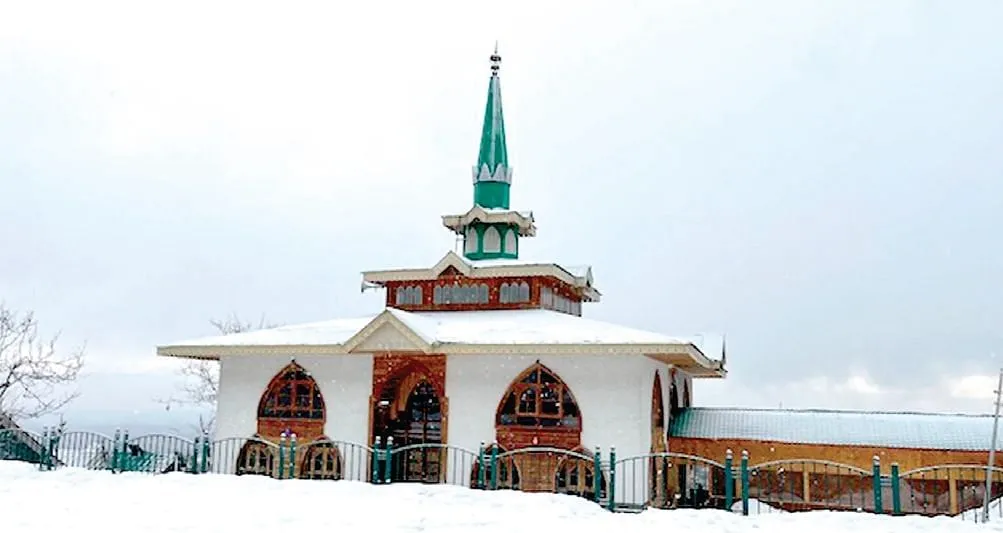The valley of Kashmir which is also called the paradise on earth, owes a lot of its charm to the traditions set in practice by the Rishis. The Rishi order which has made a very important contribution to the ethnicity, cultural harmony, patriotism and religious tolerance has translated into what is known as Kashmiriyat.
Importantly it has also contributed significantly to the spread of Islam in our region.
Sheikh Noor-ud Din, popularly known as Nund Rishi was one of the first Sufi saints who along with the Shaivite yogini, Lal Ded criticised orthodox religious practices and contributed immensely towards this.
Alamdar-e- Kashmir’s teaching were carried on by several sages, but the word Rishi always refers to Baba Payam Uddin Baba Rishi who was a disciple of Baba Zain ud Din.
In continuation to my visits to places of historic importance in the valley I decided to go to Baba Rishi, a very revered place for Kashmiris. It is located 8 kilometres from Tangmarg (meadow of pears) a town 37.5 kms from Srinagar.
The place comes as a detour on the road to Gulmarg. It happened to be a snowy afternoon, last week, which added to the beauty and charm of this pious place, which is a well-known Sufi shrine of Baba Payam Uddin Rishi.
Baba Rishi was been born in 1441 CE, to a nobleman, a minister of the contemporary ruler at Chander-nau-gaon in the region of Lar which is near the Ganderbal town of today. Payamuddin himself was a minister and a trusted man of Zain ul Abidin (Budshah) the 8th Sultan of Kashmir.
Initially he lived a life of luxury but always liked the company of sages and sought their blessings. As the legend goes, he was travelling on a horseback when he saw a row of ants working hard carrying specks of grain to their anthills. These creatures store this food in preparation of a harsh winter.
This made Baba realize that while these tiny creatures were worried about their future, he had not thought about what comes to him after death. This incident made him give up his post from the Durbar and all his worldly belongings. He then came to Baba Shukuruddin, a disciple of Nund Rishi and spent 2 years with him getting trained for leading a Sufi’s life.
He then sent him to Baba Zainuddin at Aishmuqam, a place about 15 kms from Anantnag town on way to Pahalgam. After spending a few years there on the instructions of Baba Zainuddin he moved to a small village of Ramboh.
The place was inhabited by immoral and bad charactered men, who objected to his coming there. Baba Payamuddin, counselled them and converted them to become good humans.
He spent rest of his life near a Dargah already existing there. He helped people there and preached Islam for inner purity of the hearts.
This was the land of flowers and scenic beauty and pure air with a very soothing aroma. He is said to have performed several miracles there. These included bringing the Dargah which was at a difficult to reach elevation to a lower altitude, making it easily accessible to devotees.
This was done by his mystical power of bringing the entire piece of land on which the Dargah was built to a lower level. Baba Rishi also built a kitchen with a daan (typical Kashmiri earthenware Chula) for cooking food in earthen ware vessels. People from all over the valley used to go there and plaster the daan and offer sacrifices and cook food.
This was distributed to the Langar (free eating place for public) for people visiting that place. This practice is still followed. It is also believed that childless couples are blessed with a progeny after praying there.
In addition, people go there and tie knots inside the shrine around the sanctum sanctorum (Dashei in Kashmiri) and make a wish, which according to believers is always granted.
Baba Payauddin left for his heavenly abode on 3, Zil Hajja 889 Hijri (30th December 1484) and was buried at the Ziyarat which as seen today is a three-storey monument built in a Mughal and Persian style with a big minaret. Inside the shrine is Noor Khwan where the grave of Sufi saint lies.
It is covered with a silken green cloth with writings from the holy Quran as embroideries. The Noor Khwan is made of glass and wood carvings. The Urs or the anniversary of Baba Payam Uddin Rishi, is observed annually on this date.
On 2 September 1989 the 300 years old shrine and the daan built by Baba Rishi was gutted in a fire under mysterious circumstances. The adjoining buildings were also severely damaged causing a huge loss to the historic place. It has since been rebuilt.
It is believed that whenever a fire breaks out in the shrine some severe calamity befalls on the people of Kashmir, which seems to have been proven right.
Tailpiece: Baba Rishi has been one of the legendary Sufi saints of Kashmir valley. He continued the legacy of Alamdar-e-Kashmir, Nund Rishi.
Although beginning his life as a trusted minister of Budshah Sultan Zain ul Abidin, he spent the major part of the life serving people and spreading the message of love and purity of heart through Quranic verses and helping the people in a place near Tangmarg en route to Gulmarg.
The shrine of Baba Rishi is a very popular pilgrimage for Kashmiri people, who come in large numbers and seek his blessings in getting their wishes granted. It being a very scenic place in proximity to Gulmarg, the trip is often combined with a picnic.
Prof Upendra Kaul, Founder Director Gauri Kaul Foundation, recipient of Dr B C Roy Award and Padma Shri
Disclaimer: The views and opinions expressed in this article are the personal opinions of the author.
The facts, analysis, assumptions and perspective appearing in the article do not reflect the views of GK.







